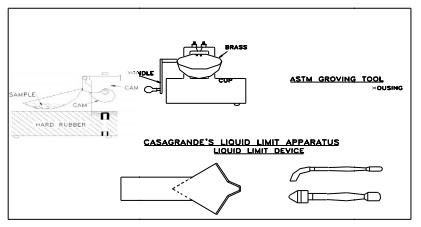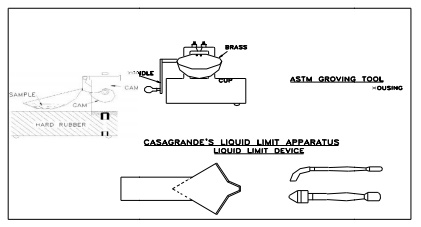Chapter: Civil : Soil Mechanics : Soil Classification And Compaction
Soil Mechanics: Sampling tools

Soil Mechanics: Sampling tools
Sampling tools:
i)Crow
bar and pickaxe along with khurpi etc.
ii)Hand
carved sampler , chunk sampling
1 Sampling Procedure:
i)Ballast shall be removed up to
the bottom of ballast penetration, and/or upto the top of subgrade i.e., just
below the blanket level. (160 cm from CL of track or 20-30 cm away from the
edge of the sleeper)
ii)Disturbed /undisturbed soil
sample (min 2.0 kg) shall be collected by excavation or other means.
iii)The excavation pit shall be at least 100 mm below the
bottom of ballast.
iv)Collected soil sample shall be kept in a poly bag with
seal, so that, fines are preserved.
v)A slip of location
(km/chainage), section, divisions alongwith name of zonal railway shall be
placed in the poly bag.
vi)The excavated pit shall be refilled with local material and
be well compacted.
Testing:
Only two types of tests shall be performed on each sample.
a) Atterberg
limit tests (Liquid Limit and plastic limit).
b) Grain
size analysis (Mechanical sieving).
Atterberg limit tests: IS: 2720 pt V 1985.
a)Equipment:
i)
Mechanical /LL apparatus
ii)
Grooving tool, Casagrande, ASTM
iii)
Procelain evaporating dish, 12 to 15cm dia
iv)
Spatula
v)
Balance (Physical or electronic)
vi)
Oven
vii)
Wash Bottle
viii) Air tight container, IS Sieve
4254 of a 600 mm x 600mm glass sheet, ix)
A soil
sample weighing about 120 g
b) Procedure:
i)
Liquid limit:
Ø Air dry
the soil sample remove the organic matter like tree roots, pieces of bark etc.
Ø About
270gm of air dried pulverized soil which is already sieved through 425 micron,
IS Sieve is taken.
Ø Water is
added with air dried soil to make a paste and ensure uniform distribution of
moisture throughout the soil mass. Clayey soil left to stand for 24 hours.
Ø A
standard groove is made in the soil paste by the grooving tool suitable for the
type of soil.
Ø The cup
is made to fall freely through a height of 1cm by turnin g e ram at the rate of
two revolutions per second.
Ø The no.
of drops re quired closing, the grave by about 12mm in the central portion is
noted.
Ø Determine
moistur e content of representative slice of soil from the groove and including
the soil fl owed.
Ø With
increasing wat er content, the number of drops required to close the groove
shall not be more than 35 or less than 15.Determine the moisture cont ent in
each case.
Ø A graph
is plotted o n semi log paper, with no. of drops on log scale as abscissa and
moisture content on natural log scale as ordinate.
Ø The water
content at 25 drops is read from the graph. It is the liquid limit (LL)for the
soil sample. Generally these points lie on a straight line.
ii)
Plastic limit:
Ø After
doing liquid limit test, the leftover soil paste is worked with a spatula on
glass sheet to drive away a part of moisture content to make it plastic enough
to be shaped into a ball.
Ø A small
mass of the plastic mass is taken of rolled on a glass she et by pressure of
the palm into a solid thr ead 3mm dia until it crumbles.
Ø These
rolls are colle cted of put into oven for drying for moisture for each test.
Ø The
average conten t is reported as plastic limit.

Related Topics